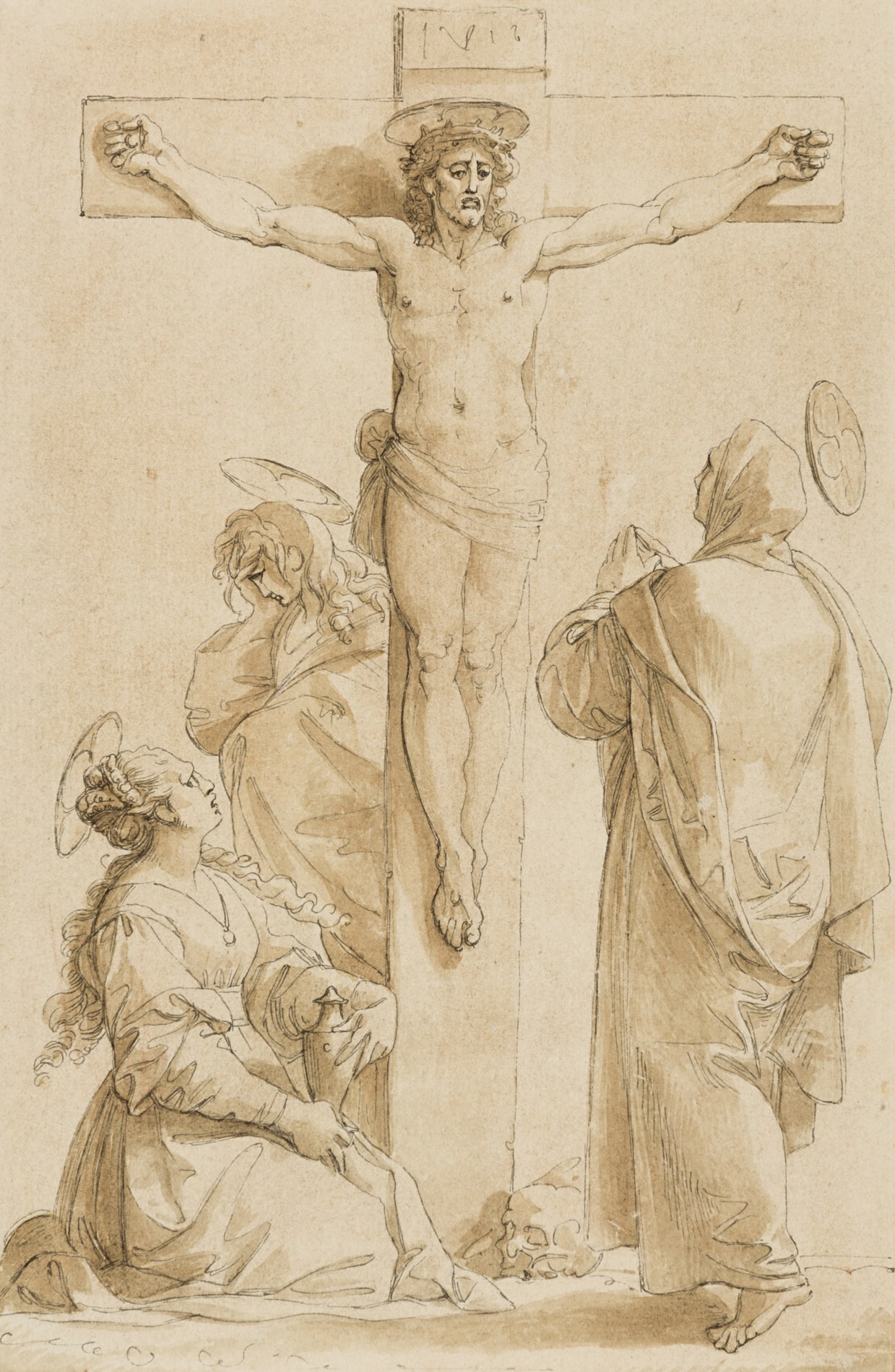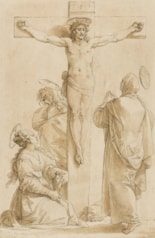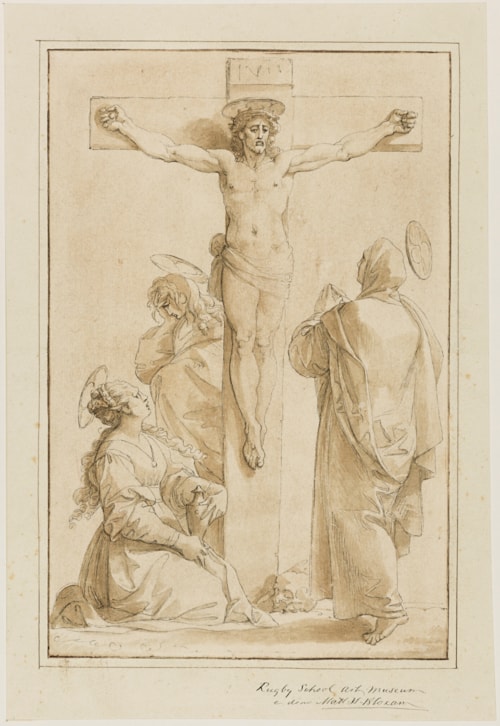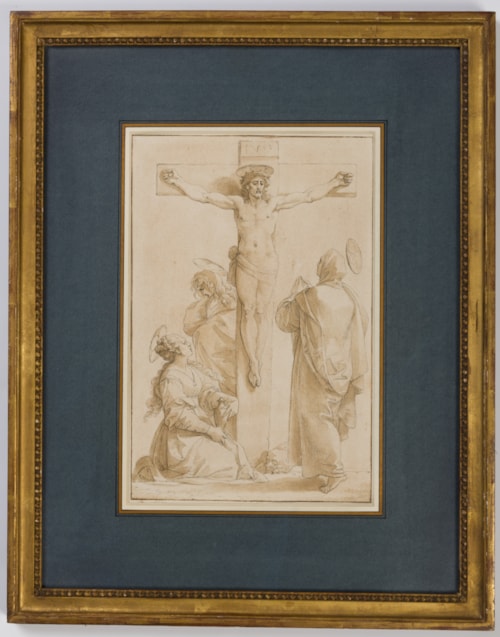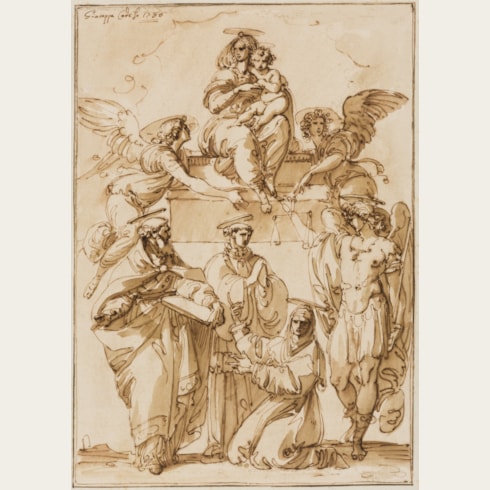Giuseppe CADES
(Rome 1750 - Rome 1799)
Christ on the Cross, with the Virgin, Saint John and Saint Mary Magdalene
Pen and grey ink and brown wash, with framing lines in brown ink.
Laid down on an early 19th century mount.
Inscribed Rugby School Art Museum / e dono Matt: H: Bloxam on the mount.
298 x 196 mm. (11 3/4 x 7 7/8 in.)
Laid down on an early 19th century mount.
Inscribed Rugby School Art Museum / e dono Matt: H: Bloxam on the mount.
298 x 196 mm. (11 3/4 x 7 7/8 in.)
From very early in his career, Giuseppe Cades was greatly admired for his drawings. Fluent in black and red chalk, pastel, pen, wash and watercolour, he was at heart as much a draughtsman as a painter, and indeed was among the most versatile and productive Italian draughtsmen of the 18th century. As a young artist in the early 1770s he seems to have supported himself through the sale of his drawings, particularly those in imitation of the work of the Old Masters. As the scholar Anthony Clark has opined of Cades, ‘From the beginning his great facility as a draughtsman was obvious, and also from the beginning he was able to produce drawings imitating the old masters which were said to be good enough to fool the best experts…And it is probable that he sold more drawings than any other living Roman.’ A significant number of Cades’s drawings were made as independent works of art, and even in his later, more successful years, he continued to produce highly finished drawings of original compositions, which were avidly collected by foreign visitors to Rome.
Drawn in Cades’s later and more finished Neoclassical manner, this fine drawing remains unrelated to any known painting by the artist, and may have been intended as a finished work in its own right. A large and stylistically analogous drawing of The Virgin Immaculate with the Christ Child, datable to the late 1780s, is in the Metropolitan Museum of Art in New York, while another comparable drawing of a Bishop Saint Blessing, likewise datable to the end of the 1780s or the beginning of the 1790s, was on the art market in Rome in 1990.
The present sheet was one of six drawings by or attributed to Giuseppe Cades in the collection of the 19th century antiquary and architectural historian Matthew Holbeche Bloxam (1805-1888), of Rugby in Warwickshire. (Each of the Cades drawings in the Bloxam collection were laid down on identical mounts, and it has been suggested that they may have been acquired together as a group, possibly from the artist’s studio estate or from one of his descendants.) Like his father before him, Bloxam had studied at Rugby School, of which he remained a devoted supporter throughout his life. When the school’s Art Museum opened in 1879, Bloxam began donating individual drawings from his collection to the museum on a yearly basis, often on his birthday.
Drawn in Cades’s later and more finished Neoclassical manner, this fine drawing remains unrelated to any known painting by the artist, and may have been intended as a finished work in its own right. A large and stylistically analogous drawing of The Virgin Immaculate with the Christ Child, datable to the late 1780s, is in the Metropolitan Museum of Art in New York, while another comparable drawing of a Bishop Saint Blessing, likewise datable to the end of the 1780s or the beginning of the 1790s, was on the art market in Rome in 1990.
The present sheet was one of six drawings by or attributed to Giuseppe Cades in the collection of the 19th century antiquary and architectural historian Matthew Holbeche Bloxam (1805-1888), of Rugby in Warwickshire. (Each of the Cades drawings in the Bloxam collection were laid down on identical mounts, and it has been suggested that they may have been acquired together as a group, possibly from the artist’s studio estate or from one of his descendants.) Like his father before him, Bloxam had studied at Rugby School, of which he remained a devoted supporter throughout his life. When the school’s Art Museum opened in 1879, Bloxam began donating individual drawings from his collection to the museum on a yearly basis, often on his birthday.
Giuseppe Cades enjoyed a highly successful, albeit relatively brief, career as one of the leading history painters and decorators in Rome in the last quarter of the 18th century. The son of a French tailor who had settled in Rome, he was a pupil of Domenico Corvi at the Accademia di San Luca. Cades was a precocious student with a particular talent for draughtsmanship, and some of his earliest drawings are dated 1762 and 1763, when he was barely a teenager. A few years later, at the age of sixteen, he won the first prize in a drawing competition at the Accademia di San Luca with a very large red chalk drawing of Tobit Curing His Father’s Blindness. Part of his artistic training was to make drawn copies after Renaissance masters, a practice he continued in his maturity. Expelled from Corvi’s studio in 1766 because of his stubborn and independent nature, Cades abandoned formal academic training and gravitated toward the community of French, Scandinavian and German artists then working in Rome - centred around the painters Johan Tobias Sergel and Johann Heinrich (Henry) Fuseli - whose work was to have a strong influence on his own. As the Cades scholar Maria Teresa Caracciolo has noted, ‘It was among these northern artists, outside the academic climate and even at odds with it, that Cades as a young man seems to have become aware of the possibilities open to him through challenging the classical rules and reverting to the Mannerist form, but in a daring and modern way, where quality and intensity of expression were concerned.’
During the first decade of his independent career, between 1770 and 1780, much of Cades’s work took the form of large, highly finished drawings of classical subjects, which he produced as autonomous works of art for sale to collectors. As Caracciolo has pointed out, ‘These drawings demonstrate the new way in which the artist looked at ancient history, conveying it with a theatrical pathos tinged with irony.’ However, the artist soon established a successful career as a painter, earning his first official commission in 1774 with an altarpiece for a church in Piedmont, while his first significant work in Rome was an altarpiece of The Ecstasy of Saint Joseph of Cupertino in the church of Santi Apostoli, painted in 1777. Cades’s later religious works included numerous altarpieces commissioned for churches in Rome and elsewhere in Italy, particularly in the late 1780s and 1790s; among the most important of these were five large paintings for the monastery of San Francesco in Fabriano, painted between 1787 and 1790. Cades was also in great demand as a decorative history painter, and among his important public commissions was the decoration of the Sala di Musica of the Palazzo Senatorio in 1779, executed in collaboration with the architect Giacomo Quarenghi. He worked in several Roman palaces, notably the Villa Borghese, the Palazzo Altieri and the Palazzo Ruspoli, as well as at the Palazzo Chigi in Ariccia.
Giuseppe Cades was among the most gifted and distinctive artists of the period; as Caracciolo has noted, ‘His paintings and drawings, which could vary in style from the baroque to the neoclassical, often appear to be fifty years ahead of their time in their quality of historical revivalism.’ He served a term as director of the Accademia del Nudo, the drawing academy in Rome founded in 1754. Among his patrons were the Empress Catherine the Great of Russia, and the royal courts of Spain and Portugal. Although he enjoyed a highly successful career, his membership in the Roman Accademia di San Luca was continually blocked by his former teacher Corvi, and it was not until 1786 that he was admitted into the institution. The last decade of his career was much occupied with his participation in the activities of the Accademia. Cades died, still at the height of his powers, at the relatively young age of forty-nine, and is buried in the basilica of Sant’Andrea della Fratte.
Important groups of drawings by Cades are today in the collections of the Museu Nacional de Arte Antiga in Lisbon (which owns an album of 126 drawings by the artist that once belonged to the Portuguese painter Domingos António de Sequeira), the Kupferstichkabinett in Berlin, the Szépmüvészeti Múzeum in Budapest, the Hermitage in St. Petersburg and the Philadelphia Museum of Art.
During the first decade of his independent career, between 1770 and 1780, much of Cades’s work took the form of large, highly finished drawings of classical subjects, which he produced as autonomous works of art for sale to collectors. As Caracciolo has pointed out, ‘These drawings demonstrate the new way in which the artist looked at ancient history, conveying it with a theatrical pathos tinged with irony.’ However, the artist soon established a successful career as a painter, earning his first official commission in 1774 with an altarpiece for a church in Piedmont, while his first significant work in Rome was an altarpiece of The Ecstasy of Saint Joseph of Cupertino in the church of Santi Apostoli, painted in 1777. Cades’s later religious works included numerous altarpieces commissioned for churches in Rome and elsewhere in Italy, particularly in the late 1780s and 1790s; among the most important of these were five large paintings for the monastery of San Francesco in Fabriano, painted between 1787 and 1790. Cades was also in great demand as a decorative history painter, and among his important public commissions was the decoration of the Sala di Musica of the Palazzo Senatorio in 1779, executed in collaboration with the architect Giacomo Quarenghi. He worked in several Roman palaces, notably the Villa Borghese, the Palazzo Altieri and the Palazzo Ruspoli, as well as at the Palazzo Chigi in Ariccia.
Giuseppe Cades was among the most gifted and distinctive artists of the period; as Caracciolo has noted, ‘His paintings and drawings, which could vary in style from the baroque to the neoclassical, often appear to be fifty years ahead of their time in their quality of historical revivalism.’ He served a term as director of the Accademia del Nudo, the drawing academy in Rome founded in 1754. Among his patrons were the Empress Catherine the Great of Russia, and the royal courts of Spain and Portugal. Although he enjoyed a highly successful career, his membership in the Roman Accademia di San Luca was continually blocked by his former teacher Corvi, and it was not until 1786 that he was admitted into the institution. The last decade of his career was much occupied with his participation in the activities of the Accademia. Cades died, still at the height of his powers, at the relatively young age of forty-nine, and is buried in the basilica of Sant’Andrea della Fratte.
Important groups of drawings by Cades are today in the collections of the Museu Nacional de Arte Antiga in Lisbon (which owns an album of 126 drawings by the artist that once belonged to the Portuguese painter Domingos António de Sequeira), the Kupferstichkabinett in Berlin, the Szépmüvészeti Múzeum in Budapest, the Hermitage in St. Petersburg and the Philadelphia Museum of Art.
Provenance
Matthew H. Bloxam, Rugby, Warwickshire
Presented by him to Rugby School, Rugby, Warwickshire, probably between 1879 and 1888.
Presented by him to Rugby School, Rugby, Warwickshire, probably between 1879 and 1888.

